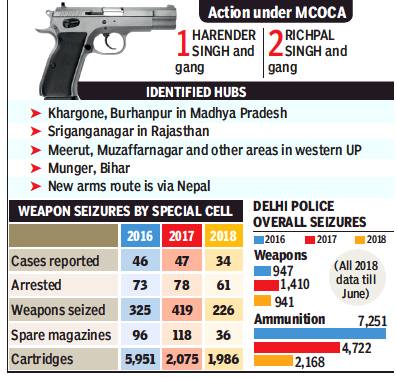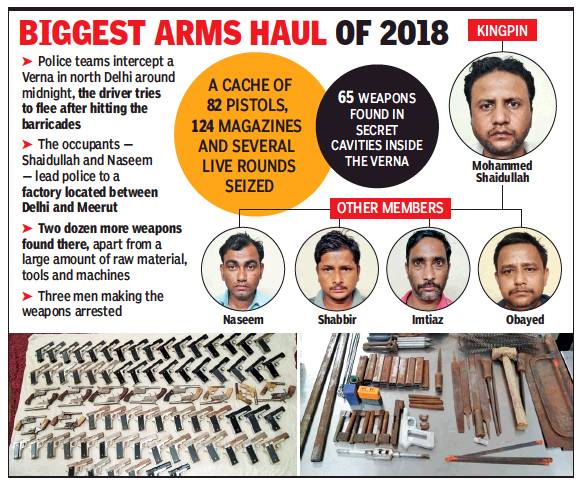Arms, illegal: India
(→Sources of illegal arms) |
|||
| Line 6: | Line 6: | ||
|} | |} | ||
| − | [[Category:India | ]] | + | [[Category:India |A ]] |
| − | [[Category:Politics | ]] | + | [[Category:Politics |A ]] |
| − | [[Category: | + | [[Category:Crime |A ]] |
= Cross-border smuggling= | = Cross-border smuggling= | ||
Latest revision as of 13:18, 5 March 2019
This is a collection of articles archived for the excellence of their content. |
Contents |
[edit] Cross-border smuggling
[edit] 2015-17
HIGHLIGHTS
Instances of cross-border smuggling of arms, drugs and cattle increased from a total of 19,537 in 2015 to 31,593 in 2017
According to the data, as many as 1,501 smugglers were arrested in 2015, 1,893 in 2016 and 2,299 in 2017
The over 3,000-km long India-China border did not report any of these instances, the data said
Instances of cross-border narcotics, arms and cattle smuggling showed a cumulative increase along with a steady rise in the number of arrests made in such cases along various Indian borders over three years, a data updated till 2017 said.
According to the data compiled by the Union Home Ministry about these criminal activities along the international borders with Pakistan, Bangladesh, Bhutan, Nepal and Myanmar, instances of cross-border smuggling of arms, drugs and cattle increased from a total of 19,537 in 2015 to 31,593 in 2017.
In 2016, as many as 23,198 such cases were registered.
India shares about 15,000-km-long land border with these countries along with China. These borders are primarily guarded by different frontier guarding forces working under the command of the home ministry.
The number of smugglers apprehended in such cross-border smuggling cases increased steadily between 2015 and 2017.
According to the data, as many as 1,501 smugglers were arrested in 2015 that went up to 1,893 in 2016 and to 2,299 during last year. A major chunk of these cases was reported from along the Indo-Bangladesh border.
The 4,000-km-long border with Bangladesh witnessed 18,132 smuggling cases in 2015 which increased to 21,771 in 2016. The number of these cases spiked to 29,693 last year, the data revealed.
However, the number of arrests of smugglers along the Indo-Bangladesh border decreased last year in comparison to 2015. As many as 656 smugglers were arrested in 2015, 751 in 2016 while 633 were held in 2017.
Among other international borders, the one with Nepal witnessed 1,158 cases of narcotics, arms and cattle smuggling in 2015. In 2016, the number of such cases was 1,173, and in 2017 it was 1,563.
In 2015, the number of cattle seized while being smuggled across the border were 1,63,180, while in 2016 it rose to 1,71,869. However last year, the number of such cattle seized was 1,30,806.
A senior official said the steady increase in these numbers, both cross-border smuggling cases and arrests, can be attributed to enhanced attempts by the smugglers as well the surveillance capabilities of the border guarding forces.
The over 3,000-km long India-China border did not report any of these instances, the data said.
[edit] The extent of the problem
[edit] Delhi: 2016- May 2018
2018 haul already matches 2016 count, June 28, 2018: The Times of India
With 941 guns seized in 2018 (till June 2018), Delhi Police is on the verge of surpassing the figure it notched up a couple of years ago. In the whole of 2016, 947 guns had been seized.
The half-yearly data released by the police force revealed that apart from 941 firearms, 2,168 rounds of ammunition were also seized. In 2017, 1,410 guns and 4,722 rounds had been seized.
The Special Cell has also made record arrests this year against people involved in arms supplying. As compared to 73 people arrested in 2016 and 78 arrests in 2017, the Cell has already arrested 61 people in the first six months.
“Stringent legal action is also brought against the habitual and top masterminds of such illegal cartels,” deputy commissioner of police (Special Cell) Sanjeev Kumar Yadav said, adding that the main manufacturing areas around Delhi are being identified.
Munger district in Bihar, Khargone in Madhya Pradesh and Meerut in Uttar Pradesh have been identified as manufacturing hubs of illegal weapons and ammunition.
Now, Delhi Police has started registering cases under Maharashtra Control of Organised Crime Act (MCOCA) against them. Senior police officers said that two of the most notorious arms suppliers of Delhi, Harender Singh and Richpal Singh, have been booked under the stringent law for the first time.
Harender was arrested on June 4 last year along with his brother Pushpender Singh and Mohit Sharma. Originally from Khair in Aligarh, Uttar Pradesh, Harender was arrested with 13 pistols. During interrogation, it was found that Harender was a key member of a countrywide cartel that manufactured and sold illegal weapons. A fresh case under MCOCA was filed against him in November.
Then Richpal was arrested, who had a reward of Rs 1 lakh on his head. He 11 pistols with him at the time of arrest. He had beeped on the police radar after four arms suppliers, who were arrested in 2016 and 2017, named him as their main supplier. From the four of them, 96 pistols had been seized.
[edit] Sources of illegal arms
[edit] Delhi: 2018

From june 28, 2018: The Times of India
See graphic :
Sources of illegal arms in Delhi: 2018
[edit] Delhi arms as good as Munger’s

From: Rajshekhar Jha, How game has changed: Pistols from Munger now made locally, October 10, 2018: The Times of India
For decades, pistols made in Bihar’s Munger have been favoured by criminals in Delhi and the National Capital Region. They don’t jam too frequently and are fairly accurate. So despite heavy surveillance on the manufacturers in Munger, the guns continued to be brought to Delhi ignoring the risks involved. The Special Cell of Delhi Police recently discovered the gun dealers have changed tack.
The cell’s investigation indicated that instead of smuggling in the weapons, the gun runners operating out of Delhi and UP have brought the arms makers from Munger to Delhi’s doorsteps, luring them with big money, accommodation and other luxuries. In return, the karigars, as they are called, have happily shifted base, glad to be under less police pressure and a more secure life from their Munger homes located in dangerous diara areas on the banks of the Ganga.
Mohammed Shaidullah, arrested on Monday night, has been in the trade for 15 years now, having begun assembling arms at an early age. For five years, he had been supplying weapons to Furqan, a Meerut-based dealer. “In order to dodge the police, Furqan convinced Shaidullah and three of his karigars to shift to Meerut and set up a manufacturing unit,” revealed Sanjeev Yadav, DCP (Special Cell).
The three karigars got Rs 2,000 for every pistol they made apart from other perks, and each made at least 15 pistols per month, the cops said. An associate named Naseem took care of the marketing.
Many clandestine gun factories have similarly mushroomed in Delhi and Meerut. “The criminals have started manufacturing firearms locally by using the skilled labour and raw material brought from Munger,” reiterated DCP Yadav.
This has not only made arms procurement easier for criminals but has also made sales and transportation a cakewalk. Till recently, Munger-made pistols were being sent to Delhi in cars, trains and trucks. Each pistol cost Rs 25,000-30,000 to the seller and reached a retail price of as high as Rs 80,000. With the shift in base, sources said the cost price had slid to Rs 15,000-18,000. Not only is the profit higher, but the risk of being apprehended — most trains from Munger and neighbouring areas are on the police radar these days — has also diminished.
Cops are interrogating the arrested men to ascertain how many factories are operating near Meerut. More arrests are likely in the coming days.